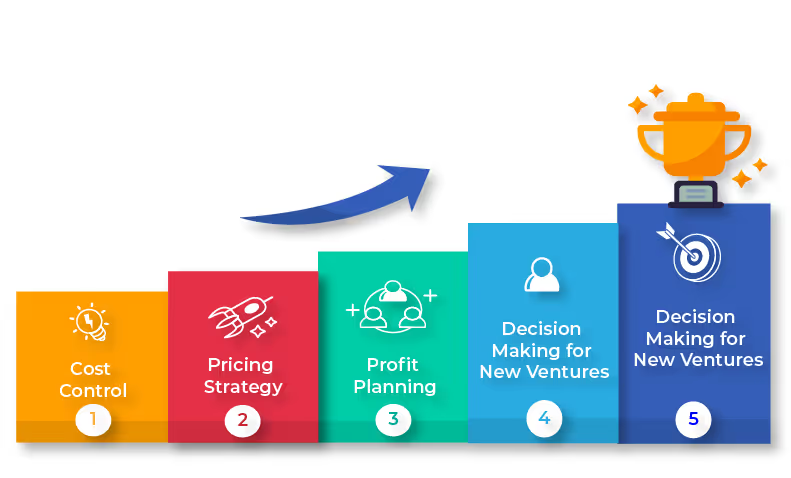
Blog
Break-Even Sales: How to Calculate and Apply in Business Strategy
September 5, 2024


Key Insights
Imagine this scenario: you are about to launch a new product. But even before you make a single sale you already know that you need to sell 10 products to avoid any loss.
It might sound like a superpower in business to make such predictions.
But it's not.
It's a simple understanding of your expenses and the sales needed to cover them.
This level of clarity on your costs will give you better insight while strategizing your sales.
And the threshold where your total cost is equal to your total revenue is called the break-even point.
In this blog, we will give you a brief about break-even sales, how to calculate break-even sales, and how businesses make use of it. We will discuss its problems and contributions to your business.
So scroll down for more.
What is the break-even point?
The break-even point is when a business makes neither profit nor loss. It refers to the point when the company has covered all its expenses through revenue generation but has not yet started making any profit.
Total cost = Total Revenue
The break-even point in sales represents the minimum amount of sales a company needs to do so that it can avoid any loss. Once this point is crossed the company starts making a profit.
How to calculate the break-even point in sales?
The break-even sales are a crucial metric to be calculated.
Calculating the break-even point formula in sales gives you a clearer idea about the sales required to overcome loss and start making a profit.
So here is the formula to calculate break-even sales:

Here,
Fixed cost refers to the price that does not change with the increase or decrease in production. Examples include building rent, employee salary, insurance, etc.

It is the percentage of each sales dollar that contributes to covering fixed costs after variable costs have been covered.
Variable cost refers to the cost that increases with the level of production. For example, raw materials, labor charges, packaging, etc.
For example, a company selling t-shirts has a fixed cost of Rs 50,000. They sell each T-shirt for Rs 100. The variable cost incurred per piece is Rs 60.
The Contribution Margin Ratio:
Hence, the business needs to generate a revenue of Rs 1,25,000 to reach the break-even point in sales.
How do businesses use the break-even point?
Businesses use the break-even point in several strategic ways to make informed decisions. Here are five key ways:

To set a competitive and profitable price for products or services.
Knowing your break-even point will help businesses determine a competitive price for their product that can cover their costs and ensure profit.
To identify and manage costs effectively.
Break-even point identifies your fixed and variable costs. If the break-even point is high then businesses can take due measures to reduce costs and thereby lower break-even point.
To establish profit goals and financial forecasts.
Break-even point shows the unit sales to be achieved to start making a profit. It helps set realistic growth targets for sales reps and financial planning for the company.
To assess the viability of new products, services, or business ventures.
Before launching a new product, businesses calculate break-even sales to check if the new sales can cover the cost. This helps make informed decisions on whether to proceed with the new initiative or not.
To monitor the ongoing financial health of the business.
Break-even point in sales is an indicator of your business's financial health. When your revenue generation falls close to the break-even point, it means there is a challenge you need to address and overcome.
Break-even point is a very useful metric for your business that helps make informed decisions on your business and financial planning.
What are the problems with break-even sales?
Now, all because you calculate break-even sales and keep track of the metrics doesn't mean everything's going to be smooth.
There are areas where break-even sales fall short of giving you the larger picture.
So let's discuss the problems of break-even sales:
- It assumes that you can sell enough products to achieve the break-even point without taking the market competition into account.
- It assumes cost as either fixed or variable. But not all costs can be neatly categorized into these two categories.
- Time factor is not considered while calculating the break-even point. It simply assumes that your product will be sold immediately.
- The break-even point formula in sales is dependent on the selling price per unit. But offers and discounts can lead to selling price fluctuation leading to reduced accuracy and consistency over the period.
- The same applies to calculating contribution margin and variable costs. All are prone to fluctuation over time affecting the accuracy and reliability of the metric.
- Break-even sales take into account historical data while estimating fixed and variable costs. But these metrics are prone to regular market fluctuation.

It must be acknowledged that break-even sales are a key metric for analyzing your business growth.
However, it must not be at the cost of overlooking these problems that come along with break-even point formulas in sales.
Why is the contribution margin important in break-even analysis?
The contribution margin is useful for break-even analysis since it tells exactly how much money from each sale is left after paying the costs that change with production—as in materials and labor.
The residual money goes to your fixed costs: rent, salaries, etc. After you've covered all of those, any extra sales fall to profit.
Your contribution margin tells you the number of products you must sell to avoid a loss. It helps in setting appropriate prices, maintaining costs, and planning for profits.
Knowing this gives the perfect tool for running a business properly.
Final Thought
Break-even sales is a metric that shows you how much you need to sell to avoid loss and achieve profit.
It is a key metric that gives a sense of direction to your salesforce on how much they need to work to ensure the company faces no setbacks.
But merely calculating your break-even point cannot improve sales performance and achievement.
For that, you need to make use of the age-old solution of incentives.
Profit in sales cannot be achieved without motivating your salesforce with rewards.
In today’s world, your salesforce does not just look for some monetary gains. They seek more.
The most important of all is transparency and clarity in the way their incentives are calculated, accounted and paid.
As a company, you can ensure all these demands by simply automating your incentive calculation and streamlining the entire process.
Book A Demo with Kennect to provide all these and more to your salesforce.
Visit Kennect to explore how automation can enhance your sales performance and company growth with just a few clicks.
ReKennect : Stay ahead of the curve!
Subscribe to our bi-weekly newsletter packed with latest trends and insights on incentives.
Thank you! Your submission has been received!
Oops! Something went wrong while submitting the form.
Your data is in safe hands. Check out our Privacy policy for more info















